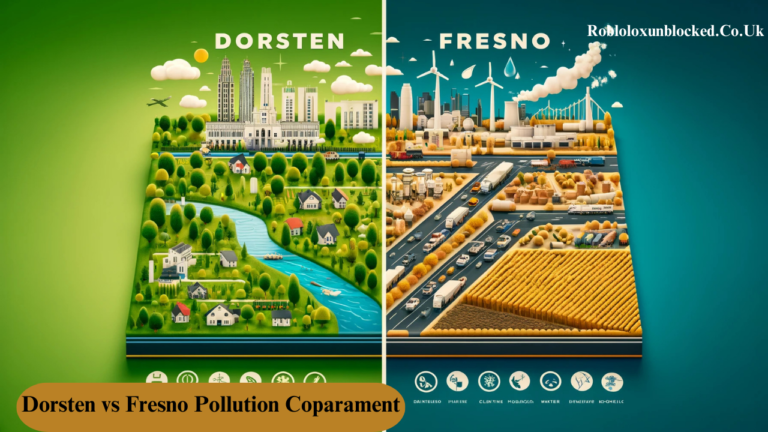Pollution has become a pressing global issue, affecting cities worldwide in various ways. Two cities that often emerge in discussions about air quality and pollution levels are Dorsten, Germany, and Fresno, California. This article aims to comprehensively compare pollution levels, sources, and impacts in Dorsten and Fresno, examining factors such as air quality, industrial contributions, and public health implications.
Understanding the Cities: Dorsten and Fresno
Dorsten: A Brief Overview
Dorsten is a town in North Rhine-Westphalia, Germany, situated near the banks of the Lippe River. Known for its historical architecture and cultural significance, Dorsten has a population of approximately 75,000 residents. The town has a mix of industrial and residential areas, contributing to its pollution levels. Industrial activities, particularly those associated with manufacturing and chemical production, play a significant role in the town’s environmental footprint.
Fresno: A Brief Overview
Fresno, located in California’s Central Valley, is one of the largest cities in the state, with a population of around 530,000. The city is an agricultural hub, producing a vast array of crops due to its fertile soil and favorable climate. However, this agricultural success comes at a cost, as Fresno faces significant challenges regarding air quality and pollution, largely attributed to agricultural practices, vehicle emissions, and industrial activity.
Pollution Levels: Analyzing Air Quality
Air Quality Index (AQI) Comparison
One of the most critical metrics for assessing pollution is the Air Quality Index (AQI). The AQI provides a standardized way to evaluate the quality of air in a given area, indicating the levels of various pollutants, including particulate matter (PM), nitrogen dioxide (NO₂), sulfur dioxide (SO₂), and ozone (O₃).
- Dorsten’s AQI: Dorsten typically enjoys moderate air quality, with AQI levels frequently falling into the “Good” to “Moderate” range. However, industrial activities can spike pollution levels, especially during specific weather conditions that trap pollutants near the ground.
- Fresno’s AQI: In contrast, Fresno often experiences poor air quality, with AQI levels frequently categorized as “Unhealthy” or “Very Unhealthy.” This is primarily due to vehicle emissions, agricultural dust, and smog formation during summer.
Specific Pollutants: A Closer Look
Particulate Matter (PM)
Particulate matter, particularly PM2.5 and PM10, is a significant concern in both cities.
- Dorsten: Industrial emissions contribute to the levels of particulate matter in Dorsten, but they are generally within acceptable limits. Seasonal variations can cause short-term spikes in PM levels, particularly in winter when heating systems are in use.
- Fresno: Fresno struggles with high levels of particulate matter, especially during the dry summer months when agricultural activities are at their peak. Dust from fields, coupled with vehicle emissions, results in elevated PM levels that can lead to respiratory issues for residents.
Ozone Levels
Ground-level ozone is another crucial factor in air quality assessments.
- Dorsten: Ozone levels in Dorsten are typically lower than those in Fresno, although they can rise during hot, sunny days when photochemical reactions occur.
- Fresno: Fresno often experiences high ozone levels, particularly in the summer. The combination of heat, sunlight, and emissions from vehicles and agriculture creates a perfect environment for ozone formation, leading to smog and health warnings.
Industrial Contributions to Pollution
Dorsten’s Industrial Landscape
Dorsten has a diverse industrial base, including manufacturing and chemical production. While these industries contribute to local employment and economic growth, they also pose challenges in terms of pollution management. The local government and industries are actively working on reducing emissions and improving environmental practices, yet industrial pollution remains a concern, especially for nearby residential areas.
Fresno’s Agricultural Impact
Fresno’s economy relies heavily on agriculture, which significantly influences its pollution levels. Pesticides and fertilizers used in farming contribute to water and air pollution. Additionally, emissions from agricultural machinery and transportation exacerbate the air quality crisis. Efforts to implement sustainable agricultural practices are underway, but the balance between agricultural productivity and environmental health remains delicate.
Health Implications of Pollution
Public Health in Dorsten
Residents of Dorsten face some health risks associated with pollution, particularly respiratory problems linked to industrial emissions. The local health authorities monitor air quality and provide guidelines for reducing exposure during high pollution days. Public awareness campaigns aim to educate citizens about the importance of air quality and personal health.
Public Health in Fresno
The health implications of pollution in Fresno are more severe. The city has one of the highest rates of asthma and other respiratory diseases in California, largely attributed to poor air quality. Vulnerable populations, including children and the elderly, are particularly at risk. Public health initiatives focus on raising awareness, improving air quality, and advocating for policy changes to combat pollution.
Efforts Toward Pollution Mitigation
Dorsten’s Initiatives
Dorsten has implemented various measures to address pollution, including stricter regulations on industrial emissions and investments in green technologies. The city encourages public transportation and cycling to reduce vehicle emissions. Community involvement in environmental protection programs is also promoted to enhance local air quality.
Fresno’s Initiatives
Fresno has taken significant steps to combat pollution, particularly by implementing the Fresno Clean Air Plan. This plan includes reducing vehicle emissions, promoting sustainable agricultural practices, and increasing public awareness about air quality issues. The city also collaborates with state and federal agencies to secure funding for air quality improvement projects.
Conclusion: A Comparative Perspective
In conclusion, comparing pollution levels in Dorsten and Fresno highlights the complexities of urban air quality management. While Dorsten benefits from moderate pollution levels and proactive measures, Fresno faces significant challenges due to its agricultural reliance and high vehicle emissions. Both cities are making strides toward reducing pollution, but the approaches and impacts vary considerably.
